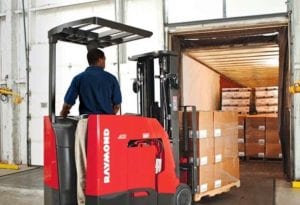Automobiles, for now, have fuel tanks. Most people who drive an automobile have a good idea of how many miles they can go on a tank. It’s helpful information to know since it will help you avoid headaches and get you to the finish line.
Electric forklifts also have fuel tanks, and batteries. And, just like a gas-powered  vehicle, that ‘tank’ will only get you so far. It’s important to make sure it has the capacity to get you to the finish line, as well.
vehicle, that ‘tank’ will only get you so far. It’s important to make sure it has the capacity to get you to the finish line, as well.
Choosing a battery that is too small can lead to short battery lifespans, and over-utilized or even ineffective equipment. Choosing a battery that is too big could cost you thousands more in upfront costs. It also can increase the needed aisle space for the lift and the operating cost over the life of the forklift due to higher battery replacement costs.
Right size your battery to match your anticipated needs
First, we need to know how much work the forklift needs to do. Let’s assume you’re  setting up a 20,000 sq. ft. warehouse and will use stand up counterbalanced forklifts, like Raymond’s model 4250. The forklifts will be used to load and offload trailers as well as access the pallet racking. Your pallets will average 2,000 pounds and the top shelf of rack will be 20 feet from the floor. The average distance traveled per run from dock to rack will be about 200 feet, and you will run a single 8-hour shift.
setting up a 20,000 sq. ft. warehouse and will use stand up counterbalanced forklifts, like Raymond’s model 4250. The forklifts will be used to load and offload trailers as well as access the pallet racking. Your pallets will average 2,000 pounds and the top shelf of rack will be 20 feet from the floor. The average distance traveled per run from dock to rack will be about 200 feet, and you will run a single 8-hour shift.
Let’s assume that it will take an average of three minutes for travel and about two minutes to lift at the dock and racking. With each run taking approximately five minutes, we will average 12 moves per hour.
Compute your consumption
Now, this is where you will likely need guidance from a knowledgeable forklift dealer. For instance, Raymond dealers have energy consumption information for each forklift model. They can calculate the energy needed to meet usage requirements.
For example, let’s assume an average kilowatt use of 60 watt-hours for each 200-foot run, and 80 watt-hours to lift 2,000-pound loads.
- 24 runs (12 to the rack and 12 back to the dock) x 60 watt-hours = 1,440 watt-hours
- 12 lifts x 80 watt-hours = 960 watt-hours
- 1,440 watt-hours plus 960 watt-hours = 2,400 watt-hours required
Now, convert watt-hours to ampere hours, which is how forklift batteries are rated.
- 2,400 watt-hours = (X) amp-hours x 36 volts (battery voltage)
- 2,400 watt-hours / 36 volts = 66.66 ampere-hours
Since batteries are rated based on a 6-hour cycle, we need to multiply the 66.66 amp-hours x 6 and we get 400 amp-hours. But we still aren’t done. We need to divide by 0.8 since we only want to use 80% of the battery’s capacity before recharging. Plus, we should add a 20% buffer for longer days and degradation of the battery capacity over time. Therefore, we’ll add 40%.
- 400 / 0.6 = 660 minimum ampere-hour battery needed to perform throughout the day
There you have it. With a little information and an experienced partner, you can determine the right battery size for your application, and make sure you cross the finish line on time!



Leave a Reply
You must be logged in to post a comment.